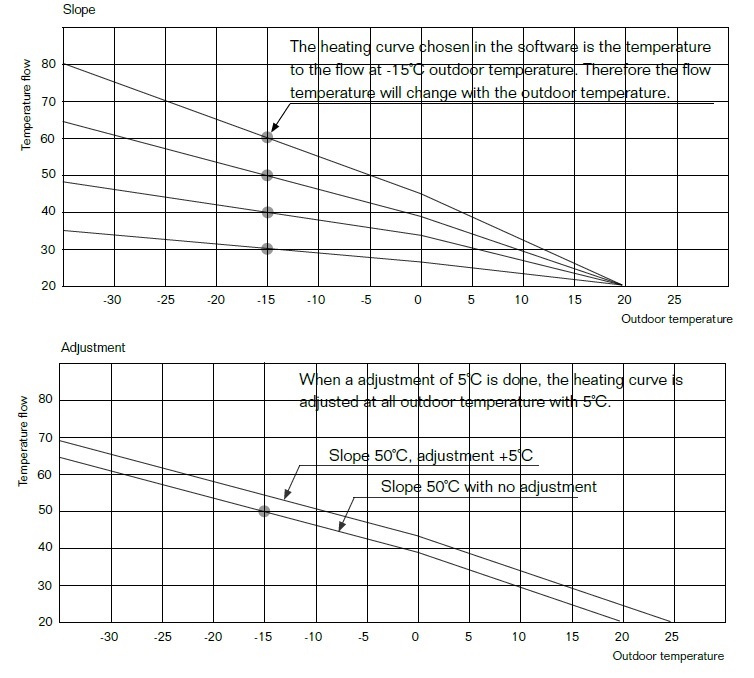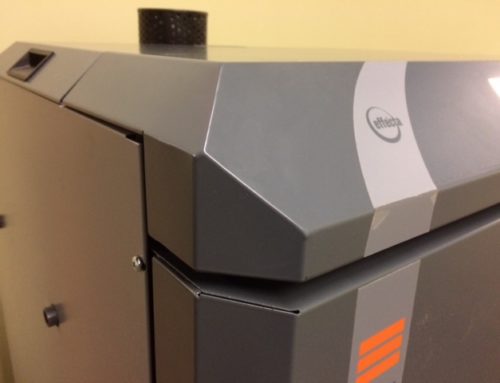 Outdoor reset is used to continually adapt a heating system to the outdoor temperature. When the air outside is cold, the heating system raises its fluid temperature inside to compensate. Warmer air outside has the opposite effect. The objective of outdoor reset is to improve or optimize the efficiency of the heating system.
Outdoor reset is used to continually adapt a heating system to the outdoor temperature. When the air outside is cold, the heating system raises its fluid temperature inside to compensate. Warmer air outside has the opposite effect. The objective of outdoor reset is to improve or optimize the efficiency of the heating system.
Outdoor Reset in Low-Mass and High-Mass Heating Systems
Outdoor reset is used in millions of buildings around the world, in various types of hydronic central heating systems. Typical systems using outdoor reset are geothermal heat pumps, and hot water boilers fueled by heating oil, propane, natural gas, wood, and wood pellets. In its most common configuration, the outdoor temperature is used to determine the boiler (or heat pump) output temperature. In many cases where the system is low-mass (i.e. low water content), this means the output temperature quickly adapts to the outside temperature. However, this isn’t the reality where there is large thermal storage, such as is the case with geothermal heat pumps and pellet boilers. High thermal mass leads to a long lag for the reservoir of heat to adapt to the outdoor temperature. In fact, the outdoor temperature is a moving target, and so like a broken clock*, the temperature of the thermal storage may only be optimized to the outdoor temperature for a few moments each day.
Electronic controllers may try to compensate by accounting for some of these changes with time-of-day settings. It’s usually colder at night than in the day, so the control may boost the boiler or storage tank temperature during nighttime hours. The problem with this approach is that storage tanks hold a lot of heat, often several hours worth, and they’re insulated, so there’s a long lag when attempting to adapt the temperature in the tank to the outside temperature. This lag is also apparent outside of the context of night and day. Outdoor temperatures can change over a wide band from day to day, and even hour to hour. Therefore, outdoor reset as it’s typically used for low mass heating systems, is not going to optimize the efficiency of a pellet boiler**.
Where Outdoor Reset Works Best in High-Mass Systems
Fortunately, there are better ways to use outdoor reset with buffer tank-equipped heating systems, Rather than try to change the temperature parameters of the water in the tank, outdoor reset can be used to control the temperature of the fluid in the heat delivery circuits; that is, the fluid going to the heat emitters (e.g. baseboard, panel radiators, radiant floors, etc.). By using a motorized mixing valve (aka shunt valve), returning water from the heat emitters is mixed with the hotter water leaving the buffer tank. The fluid temperature can be adjusted more or less constantly by the mixing valve with the help of outdoor reset and heating curves built into the boiler (or separate) control.
In the optimal case, the fluid can run constantly through the heating circuits without a great expense of energy by using a single ECM circulator. The fluid temperature (after the shunt valve mix) is dependent on the outside temperature. It is determined by a sloping curve, where colder temperatures outside mean warmer circulating fluid temperature, and vice versa.
A nice advantage of this arrangement is that the interior temperature stays pretty constant. There’s none of the repeated on/off which is so common with other system arrangements. Because the fluid temperatures are changing so slowly, you also avoid the expansion and contraction ticking noises that are so familiar to people with baseboard radiators and in-floor and sub-floor radiant heating.
Domestic Hot Water
If there’s an indirect tank that’s also being heated by the system, that tank should be on a separate circuit. If not, it will take a long time to reheat the domestic hot water (DHW) when the outdoor temperatures are mild.
*As the saying goes, “even a stopped clock is right twice a day”.
**The value of a buffer/accumulator tank is high when the boiler (or heat pump) has low water volume (e.g. <10 to 15 gallons) and when the ignition and “damping down” (as in some pellet boilers) is slow. Some boilers, like the Effecta Komplett III have larger water content (26 gal.) and fast ignition and damping down phases, so the value-add of a buffer tank is less.






Leave A Comment